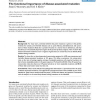Free Online Productivity Tools
i2Speak
i2Symbol
i2OCR
iTex2Img
iWeb2Print
iWeb2Shot
i2Type
iPdf2Split
iPdf2Merge
i2Bopomofo
i2Arabic
i2Style
i2Image
i2PDF
iLatex2Rtf
Sci2ools
BMCBI
2002
2002
The functional importance of disease-associated mutation
Background: For many years, scientists believed that point mutations in genes are the genetic switches for somatic and inherited diseases such as cystic fibrosis, phenylketonuria and cancer. Some of these mutations likely alter a protein's function in a manner that is deleterious, and they should occur in functionally important regions of the protein products of genes. Here we show that disease-associated mutations occur in regions of genes that are conserved, and can identify likely disease-causing mutations. Results: To show this, we have determined conservation patterns for 6185 non-synonymous and heritable disease-associated mutations in 231 genes. We define a parameter, the conservation ratio, as the ratio of average negative entropy of analyzable positions with reported mutations to that of every analyzable position in the gene sequence. We found that 84.0% of the 231 genes have conservation ratios less than one. 139 genes had eleven or more analyzable mutations and 88.0% o...
Related Content
| Added | 17 Dec 2010 |
| Updated | 17 Dec 2010 |
| Type | Journal |
| Year | 2002 |
| Where | BMCBI |
| Authors | Sean D. Mooney, Teri E. Klein |
Comments (0)

